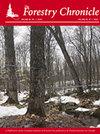How do tree- and stand-level factors influence belowground biomass and carbon storage in tanoak (Notholithocarpus densiflorus)?
IF 0.8
4区 农林科学
Q3 FORESTRY
引用次数: 0
Abstract
Tanoak (Notholithocarpus densiflorus) is the most common hardwood in northern California forests, yet its capacity for belowground carbon storage is unknown. To study relationships between coarse roots and tree and stand variables, we destructively sampled twelve tanoak root systems in Humboldt County, California. To estimate belowground biomass, we summed measured biomass of the root ball and a subsample of lateral roots along with predicted biomass of unmeasured coarse roots. Tree size was the best linear predictor of belowground biomass and carbon, indicating that a 25-cm diameter tanoak, for example, stored 70 kg of biomass and 34 kg of carbon in its root system. Stand density was also influential: a doubling of stand density index reduced belowground carbon by 22% for the average tanoak. The mean root-toshoot ratio of 0.35 varied between 0.11 and 0.65, with larger tanoak at high stand densities allocating proportionally less biomass belowground than small open-grown tanoak. The findings highlight the importance of accounting for stand density effects, otherwise belowground carbon will be under predicted in low-density stands managed for tree health, vigor, and resistance to drought and wildfire, or overestimated in forests managed at high densities for high carbon sequestration.树木和林分水平因子如何影响橡树(Notholithocarpus densiflorus)地下生物量和碳储量?
Tanoak (Notholithocarpus densiflorus)是北加州森林中最常见的硬木,但其地下碳储存能力尚不清楚。为了研究粗根与树木和林分变量之间的关系,我们对美国加利福尼亚州洪堡县的12个栎树根系进行了破坏性取样。为了估计地下生物量,我们将根球和侧根的测量生物量与未测量的粗根的预测生物量相加。树的大小是地下生物量和碳的最佳线性预测因子,例如,一棵直径25厘米的橡树在其根系中储存了70公斤的生物量和34公斤的碳。林分密度也有影响:林分密度指数增加一倍,平均栎树的地下碳减少22%。平均根冠比为0.35,变化范围在0.11 ~ 0.65之间,高林分密度的大栎树分配的地下生物量比例低于露天生长的小栎树。研究结果强调了考虑林分密度效应的重要性,否则,在低密度林分中,为了树木的健康、活力和对干旱和野火的抵抗力,地下碳将被低估,或者在高密度管理的森林中,为了高碳固存,地下碳将被高估。
本文章由计算机程序翻译,如有差异,请以英文原文为准。
求助全文
约1分钟内获得全文
求助全文
来源期刊

Forestry Chronicle
农林科学-林学
CiteScore
1.20
自引率
0.00%
发文量
6
审稿时长
18-36 weeks
期刊介绍:
The Canadian Institute of Forestry has published The Forestry Chronicle, a professional and scientific forestry journal, since 1925. The Forestry Chronicle is published to provide information to forest practitioners about professional and scientific management of forests and their resources. The Forestry Chronicle provides forest practitioners in Canada and around the world with a means to communicate with their peers in the professional community.
 求助内容:
求助内容: 应助结果提醒方式:
应助结果提醒方式:


